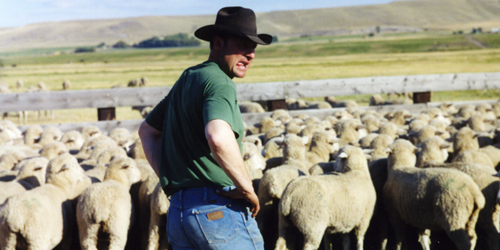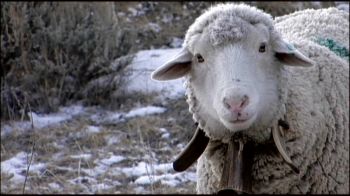Director Lucien Castaing-Taylor on the Making of Sweetgrass | reviews, news & interviews
Director Lucien Castaing-Taylor on the Making of Sweetgrass
Director Lucien Castaing-Taylor on the Making of Sweetgrass
A dogged director on why he spent years shooting an elegy to sheep-herders
I grew up in Liverpool, but my grandmother was from the Lake District - Wordsworth country, and about as rural and remote as could be. We used to stay with her on weekends, and I still remember the sense of freedom as we escaped the post-industrial detritus of Merseyside and Lancashire, and approached her cottage in this Arcadian paradise. But my bucolic fantasy was of course the projection of an urban child, who knew next to nothing about what it was like to actually inhabit this landscape, whether as a farmer, a sheep, a cow, a fox, or any other animal I spent my weekends gazing at.
Decades later, I found myself living in Colorado. In the spring of 2001, we heard about a family of Norwegian-American sheep-herders in Montana, who were the last to be trailing their band of sheep long distances - about 150 miles each year, all of it on hoof, up to the mountains for summer pasture. I could not believe there was anywhere so remote in the lower 48 states. It took them five weeks to drive their sheep from the ranch to the basins at 11,000 ft where they pass their summers, and this in the 21st-century USA.
I visited them that April during lambing, and was so taken with the magnitude of their life - at once its allure and its arduousness - that we ended up working with them, their friends, and their Irish-American hired hands intensively over the coming years. Sweetgrass is one of nine films to have emerged from the footage we have shot over the last decade, the only one intended for theatrical exhibition.

As they have been shaped through editing, the films seem to have become as much about the sheep as about their herders. The humans and animals that populate them commingle and crisscross in ways that have taken us by surprise. Sweetgrass depicts the twilight of a defining chapter in the history of the American West, the dying world of Western herders - descendants of Scandinavian and northern European homesteaders - as they struggle to make a living in an era increasingly inimical to their interests.
Set in "Big Sky" country, in a landscape of remarkable beauty and a scale almost unimaginable to Europeans, the film portrays a life-world coloured by an intense propinquity between nature and culture - one that has been integral to the fabric of human existence throughout history, but which is inconceivable for the urban masses of today.
As we began work on the film, I returned to Wordsworth, and when re-reading Michael I realised he was anything but the unfettered romanticist I remembered him as. Until Wordsworth, the whole pastoral tradition, from Theocritus and Virgil, through Petrarch and Garcilaso, to Marot and Spenser - had idealised and allegorised shepherds out of bodily existence. Where would you ever encounter a shepherd snoring, peeing or cursing the loneliness or drudgery of the work?
And so with Sweetgrass, where we transposed the pastoral to the American West, we sought to convey at once the allure and the ambivalence of the pastoral. We resolved to give as authentic a sense as we could of what it was like to spend months at a time alone with 3,000 sheep in your charge high in the mountains.
 We also - preposterously perhaps - tried to evoke what it was like to be one of those charges, to be a sheep in an impossibly large band herded up to 11,000 ft the moment the snow melts, and down again just as autumn approaches. In a sense, we bestialise the humans and subjectify and at times anthropomorphise the sheep.
We also - preposterously perhaps - tried to evoke what it was like to be one of those charges, to be a sheep in an impossibly large band herded up to 11,000 ft the moment the snow melts, and down again just as autumn approaches. In a sense, we bestialise the humans and subjectify and at times anthropomorphise the sheep.
I wore the camera on a harness all day long, whether I was filming or not, so that human and ovine alike would become indifferent to it, and just be themselves without constantly composing themselves for the camera. I foreswore interviews, scripting and re-enactments, as I was more concerned, as James Agee famously put it, “to perceive simply the cruel radiance of what is” than to listen to people interpreting their lives after the fact, with all of the attenuation and affectation that allows.
And when I was not filming - which was most of the time - I learned to be a herder.
As it happens, we ended up documenting the last sheep drive there will ever be into the Absaroka and Beartooth mountains. Supplementing your deeded land with grazing permits on barren public lands has been integral to the American West since homesteading days. But economic pressures and urban environmentalists have conspired to bring the century-old tradition to an end. The ranch is sold, to a New York banker who visits for a couple of weeks each summer. The sheep have been taken to market. The herders now work as hired hands down on the flat lands - breaking horses, putting up fences, helping out with calving. The mountain wilderness has been restored to itself, except for the occasional hunter or hiker.
And the film Sweetgrass is complete, a modest record of a world that is suddenly no more. Spending the summers high in the Rocky Mountains, among the herders, the sheep and their predators, was a transcendent experience that will stay with me for the rest of my days.
- Sweetgrass is released today. Read theartsdesk review
Watch the trailer for Sweetgrass
Share this article
more Film
 Blu-ray: The Dreamers
Bertolucci revisits May '68 via intoxicated, transgressive sex, lit up by the debuting Eva Green
Blu-ray: The Dreamers
Bertolucci revisits May '68 via intoxicated, transgressive sex, lit up by the debuting Eva Green
 theartsdesk Q&A: Marco Bellocchio - the last maestro
Italian cinema's vigorous grand old man discusses Kidnapped, conversion, anarchy and faith in cinema
theartsdesk Q&A: Marco Bellocchio - the last maestro
Italian cinema's vigorous grand old man discusses Kidnapped, conversion, anarchy and faith in cinema
 I.S.S. review - sci-fi with a sting in the tail
The imperilled space station isn't the worst place to be
I.S.S. review - sci-fi with a sting in the tail
The imperilled space station isn't the worst place to be
 That They May Face The Rising Sun review - lyrical adaptation of John McGahern's novel
Pat Collins extracts the magic of country life in the west of Ireland in his third feature film
That They May Face The Rising Sun review - lyrical adaptation of John McGahern's novel
Pat Collins extracts the magic of country life in the west of Ireland in his third feature film
 Stephen review - a breathtakingly good first feature by a multi-media artist
Melanie Manchot's debut is strikingly intelligent and compelling
Stephen review - a breathtakingly good first feature by a multi-media artist
Melanie Manchot's debut is strikingly intelligent and compelling
 DVD/Blu-Ray: Priscilla
The disc extras smartly contextualise Sofia Coppola's eighth feature
DVD/Blu-Ray: Priscilla
The disc extras smartly contextualise Sofia Coppola's eighth feature
 Fantastic Machine review - photography's story from one camera to 45 billion
Love it or hate it, the photographic image has ensnared us all
Fantastic Machine review - photography's story from one camera to 45 billion
Love it or hate it, the photographic image has ensnared us all
 All You Need Is Death review - a future folk horror classic
Irish folkies seek a cursed ancient song in Paul Duane's impressive fiction debut
All You Need Is Death review - a future folk horror classic
Irish folkies seek a cursed ancient song in Paul Duane's impressive fiction debut
 If Only I Could Hibernate review - kids in grinding poverty in Ulaanbaatar
Mongolian director Zoljargal Purevdash's compelling debut
If Only I Could Hibernate review - kids in grinding poverty in Ulaanbaatar
Mongolian director Zoljargal Purevdash's compelling debut
 The Book of Clarence review - larky jaunt through biblical epic territory
LaKeith Stanfield is impressively watchable as the Messiah's near-neighbour
The Book of Clarence review - larky jaunt through biblical epic territory
LaKeith Stanfield is impressively watchable as the Messiah's near-neighbour
 Back to Black review - rock biopic with a loving but soft touch
Marisa Abela evokes the genius of Amy Winehouse, with a few warts minimised
Back to Black review - rock biopic with a loving but soft touch
Marisa Abela evokes the genius of Amy Winehouse, with a few warts minimised
 Civil War review - God help America
A horrifying State of the Union address from Alex Garland
Civil War review - God help America
A horrifying State of the Union address from Alex Garland

Add comment